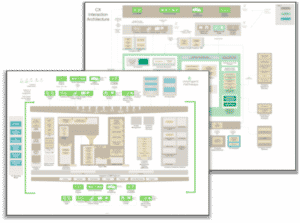Cloud and the rise of Software as a Service (SaaS) solutions has put organisations on somewhat of an even playing field when it comes to Customer Experience (CX) & Marketing Technology (MarTech). Just about any organisation from a large university through to a medium sized health organisation can and are implementing market leading Client Relationship Management (CRM) or Marketing Automation platforms.
So if everyone is ‘doing CX’ how can you get a competitive edge with your CX technology? In our experience the answer often lies in building complementary data and integration capabilities that connect MarTech to the organisation’s enterprise technology systems, leveraging data across the enterprise.
In this article I will discuss some of the common challenges we’ve seen around CX technologies, the lessons learnt from our recent CX engagements and how a robust data and analytics capability will bolster your competitive advantage.
Common CX Technology Challenges
For many organisations,improved customer experience is a primary driver for their digital transformation programs, which in turn places great focus (and budget) on MarTech at the enterprise level. This elevation is great for customers, students, patients, passengers, clients, citizens and tenants alike but it has presented some challenges for organisations, particularly those who have not traditionally focused on CX. Some of the common challenges we’ve seen around the CX technology are outlined below.
Right-Fit Technology Selection
There has been a surge in the depth and breadth of CX technologies available in the market, many of which have overlapping functions. Such choice can make it difficult to isolate which platforms/ modules you actually need and the vendor strategy you should take – ‘all in’ or ‘best-of-breed’ CRM and Marketing Automation tools from different vendors? A deep understanding of system features and administration is needed to determine which combination of technologies will best fulfil your business requirements.
Lost Insights
There is no shortage of data in the customer experience domain but without access, structure or governance key insights can be lost in a ‘wall of noise’ t. We have seen this particularly in large fragmented organisations where there is limited visibility between sub-divisions and opportunities are being missed. For example, in a community health organisation a patient may require multiple services such as dental, physiotherapy and nutrition services but that patient may not be aware that such extended services are available, or the organisation may not have cohesively captured that need at an enterprise level.
Demonstrating Return on Investment
Demonstrating return on investment of the Marketing function has always been challenging due to the intangible nature of marketing activities and sentiment. CX technologies certainly help with this but a CRM solution alone can not tell you the number of engagements/ touch points of a prospect before becoming a customer, what makes an account or opportunity more profitable or identify areas to streamline cost of sale.
Lessons Learnt from CX Transformations
Marketing and IT Alignment is Critical
Customer expectations are at an all time high when it comes to digital experience. They want a seamless experience from search (acquisition) to delivery (order fulfilment), tailored content and offers based on their preferences and rapid executions once they’ve made a decision. None of these expectations can be met without integration between MarTech and enterprise technology systems.
It can be difficult for Marketing and IT teams to get on the same page at times. They often speak different ‘languages’, consume information in different ways and there can be misconceptions on both sides about how fast or easy it should be to deliver on requirements. Many of these challenges can be overcome by embedding Customer Centricity thinking holistically across your organisation, a topic I addressed in my previous blog Architectural Principles for Customer Centricity.
Plan your Integration Strategy
Many MarTech solutions come with pre-built connectors that promise to seamlessly embed your new solution into your technology environment. And for smaller organisations with straightforward use cases, this approach is timely and cost effective. However for larger organisations with business processes spanning across multiple systems and significant data transformation requirements, the plug and play approach is unlikely to meet all of their needs.
Taking the time to appreciate integration impacts and build a solid integration architecture will ensure that you can fulfil your end-to-end business requirements and ensure your solution can live up its promised potential. It will also allow you to switch out systems in the future without significant impacts on your business processes.
Don’t Underestimate Data Migration
Unless you’re a greenfield organisation, you need to be planning for data migration. It might seem like a boring activity but we have seen several large SaaS implementations come unstuck due to underestimating the complexity around data migration. Spending the time on detailed data mapping to load the historic data into the new system and putting in appropriate data quality controls will ensure a smooth transition to your shiny new CRM solution.
Building a Competitive Edge with Data
Every business is striving to be data-driven and the CX domain in particular is looking to data to hyper-personalise customer experience, strengthen relationships at all stages of the customer’s life journey and find the next opportunity to expand share of wallet. This level of data currency requires more than system implementations – it requires a mature data capability that provides access, visibility and governance around customer data in every system across your organisation. This includes a targeted data architecture that services the needs of different data roles including owners, analysts, scientists and stewards, and identifies the data they need to keep the ‘wall of noise’ at bay.
Analytics is also a critical component to building your competitive edge. Going beyond the standard reporting metrics around ‘likes’, click-through rates and leads generated is needed to deliver next level return on investment. Uncovering the metrics that demonstrate the types of customers or deals that are most profitable and identifying what would be transformative for those customers which is what ‘The Top 100 Most Customer-Centric Companies Of 2022 such as Shopify, Apple and AirBnB are doing with great success.
Implementing CX technology is an important first step in building a competitive edge. To truly stand out from your competitors, aligning a data and integration strategy/architecture will lead to the gems within your wider data ecosystem and provide a superior customer experience based on personalisation and understanding.



